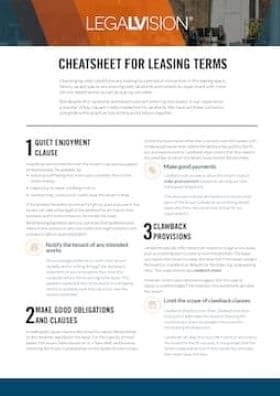It is common for leases, particularly retail leases, to include an incentive to encourage entry into the lease. For example, this incentive could be money or a benefit that the landlord provides. It is also common for those leases that provide lease incentives to include clawbacks. A clawback provides the landlord with an entitlement to a refund of a portion or all of the incentive if certain events occur, such as early lease termination. However, some case law may suggest that these provisions are unenforceable because the law considers them to be penalty provisions. This article will discuss:
- what are clawback provisions; and
- under what circumstances the law will consider a clawback provision to be a penalty.
What is a Clawback Provision?
As part of your lease, the landlord may offer you an incentive for:
- entering into the lease; and
- making improvements to the premises.
The most common forms of incentive are the following:
| Incentive | Explanation |
| Rent-Free Periods | The landlord will not require you to pay rent for a specific period from the commencement date of the lease. |
| Rent Reductions | The landlord reduces a portion of the rent each month until you use up the total incentive amount. |
| Fitout Contributions | The landlord pays for your fitout by way of reimbursement of the fit-out costs to an agreed sum. Alternatively, the landlord may carry out the fit-out works on your behalf. |
As part of the incentive, a clawback provision will commonly be included in the lease or a separate incentive deed. Clawback provisions generally require the tenant to refund or pay back all or a portion of the incentive they have received under certain circumstances. The most common types of trigger events for a clawback include:
- if the tenant defaults or breaches the lease;
- if the tenant assigns the lease or is deemed to have assigned the lease; or
- the landlord otherwise terminates the lease before the expiry of the term.
Depending on the incentive provisions, how much of the incentive the tenant will have to pay back is generally based on how far through the term they are. For example, for a five-year lease, the clawback may be apportioned as follows:
- first year of the term, the tenant pays back 100% of the incentive;
- second year of the term, the tenant pays back 80% of the incentive;
- third year of the term, the tenant pays back 60% incentive;
- fourth year of the term, the tenant pays back 40% of the incentive; and
- five year of the term the tenant pays back 20% of the incentive.
What Makes a Clawback a Penalty Provision?
Generally, the law will consider a contract provision a penalty if it does not represent a genuine pre-estimate of loss. The law considers such a clause a penalty because it essentially imposes a ‘fine’ on one party.
As a result, some courts have determined that clawback provisions are penalties. For example, a Queensland court found that a clawback clause was unenforceable. In this case, the lease was terminated because the tenant abandoned the property. As a result, the landlord received an incentive from both the fitout and rent reduction. Upon termination, the court determined that while the landlord may seek damages, the landlord could not seek a refund of the incentive. This was because the incentive amount was not a legitimate estimate of the loss the landlord was suffering. After all, if the tenant did not breach the lease, the landlord would never have received this amount.
Similarly, in Victoria, the court decided that a landlord could not make a claim under the clawback provision. In this instance, the tenant had received an incentive from the landlord, which consisted of a contribution to its fitout and a rent reduction. When the lease terminated early, the landlord sought to enforce the clawback provision. The court found that the money the landlord sought was not proportionate to the damage the landlord suffered and deemed the clawback provision a penalty.
How Do These Decisions Affect Your Lease or Incentive Arrangement?
In some situations, a clawback genuinely represents the landlord’s loss. In this instance, the clause will be enforceable. Nevertheless, if your lease or deed has a clawback provision, you should negotiate the terms.
Suppose you are unsuccessful in negotiating the clawback out. In that case, it is still important to carefully review and take note of any provision in your lease or deed requiring you to repay part or all of your incentive. If there is such a provision, you should note when and how the clawback will arise and how much you must pay back.

This cheat sheet explains the key clauses you need to be aware of as a landlord in a lease agreement.
Key Takeaways
In commercial lease agreements, it is common to find clawback clauses that require the tenant to pay back part or all of the incentive they have received from the landlord if the lease terminates early. Whether or not the provision is enforceable will depend on the circumstances of the case. This can give some comfort to tenants seeking to negotiate leases and incentives, although you should always seek to remove any clawback provision in the first instance.
If you have any questions about clawback clauses, our experienced leasing lawyers can assist you as part of our LegalVision membership. For a low monthly fee, you will have unlimited access to lawyers to answer your questions and draft and review your documents. Call us today on 1300 544 755 or visit our membership page.
We appreciate your feedback – your submission has been successfully received.











